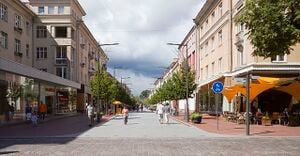
Community energy
Renewable energy in Lithuania constitutes some energy produced in the country. In 2016, it constituted 27.9% of the country's overall electricity generation. Previously, the Lithuanian government aimed to generate 23% of total power from renewable resources by 2020, the goal was achieved in 2014 (23.9%).
Climate action, environment quality, and recycling
After the restoration of Lithuania's independence in 1990, the Aplinkos apsaugos įstatymas (Environmental Protection Act) was adopted already in 1992. The law provided the foundations for regulating social relations in the field of environmental protection, established the basic rights and obligations of legal and natural persons in preserving the biodiversity inherent in Lithuania, ecological systems and the landscape. Lithuania agreed to cut carbon emissions by at least 20% of 1990 levels by 2020 and by at least 40% by 2030, together with all European Union members. Also, by 2020 at least 20% (27% by 2030) of the country's total energy consumption should be from the renewable energy sources. In 2016, Lithuania introduced especially effective container deposit legislation, which resulted in collecting 92% of all packagings in 2017.
Sustainable transport
There are 600 kilometres (370 mi) that are perennially navigable.
Rivers
There are 29,000 rivers with a total length of 64,000 km in Lithuania, the Nemunas River basin occupying 74% of the territory of the country. Due to the construction of dams, approximately 70% of spawning sites of potential catadromous fish species have disappeared. In some cases, river and lake ecosystems continue to be impacted by anthropogenic eutrophication. W
Trees, woodland and forest
Forests cover 33% of the country's territory. W
Wetlands
Wetlands (raised bogs, fens, transitional mires, etc.) cover 7.9% of the country, with 70% of wetlands having been lost due to drainage and peat extraction between 1960 and 1980. Changes in wetland plant communities resulted in the replacement of moss and grass communities by trees and shrubs, and fens not directly affected by land reclamation have become drier as a result of a drop in the water table. W
About Lithuania
Lithuania ( LITH-yoo-AYN-ee-yə; Lithuanian: Lietuva [lʲiətʊˈvɐ]), officially the Republic of Lithuania (Lithuanian: Lietuvos Respublika [lʲiətʊˈvoːs rʲɛsˈpʊblʲɪkɐ]), is a country in the Baltic region of Europe. It is one of three Baltic states and lies on the eastern shore of the Baltic Sea. It borders Latvia to the north, Belarus to the east and south, Poland to the south, and Russia to the southwest, with a maritime border with Sweden to the west. Lithuania covers an area of 65,300 km2 (25,200 sq mi), with a population of 2.86 million. Its capital and largest city is Vilnius; other major cities are Kaunas, Klaipėda, Šiauliai and Panevėžys. Lithuanians belong to the ethnolinguistic group of the Balts and speak Lithuanian, one of only a few living members of the Baltic branch of the Indo-European language family, which is also the most widely spoken language of the branch.